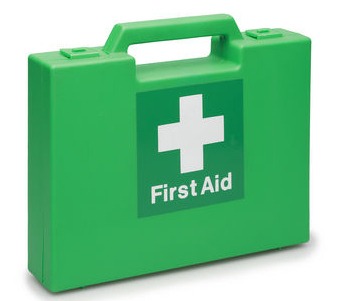First-Aid Basics for Boaties
Paul Neilson: Paul is a an active member of the Gold Coast Sportfishing Club and Executive Committee. On the professional front Paul has been a Paramedic for over 25 years and he shares a few first aid tips for boaties.
First Aid is a term we  hear regularly in our day to day life but unfortunately only a few of us know how too apply up to date Basic First Aid and CPR procedures or are willing to get involved in situations that we may come across. Due to this mind set, vital seconds and minutes depending on the situation and condition of the patient are lost waiting for the Ambulance Paramedics to arrive.
hear regularly in our day to day life but unfortunately only a few of us know how too apply up to date Basic First Aid and CPR procedures or are willing to get involved in situations that we may come across. Due to this mind set, vital seconds and minutes depending on the situation and condition of the patient are lost waiting for the Ambulance Paramedics to arrive.
Over the past 25 year in my career as an Advanced Care Paramedic I’ve attended a wide variety of life threatening and non life threatening cases. In November 1998 I arrived on the Gold Coast to start my new position as a Marine Paramedic based with the Queensland Water Police responding to marine and remote cases ranging from spinal injuries on the eastern side of South Stradbroke Island, jet ski and boating accidents, marine envenomations, snake bites and burns, cuts and abrasions and general medical conditions.
If you own a boat or take your family out on our busy waterways a First Aid Certificate and a clean in date first aid kit is a must and should be something you check on a regular basis along with your life jackets, flares and EPIRB.
First Aid courses are run by many organisations and all cost approx the same and go for 2-5 days depending on the type of course, but my advice is to undertake a course with an accredited body such as a State Ambulance Service or Royal Life Saving Society.
A basic first aid kit should contain : Bandages
: Sterile Dressings and Pads
: Antiseptic Wash
: Band Aids
: Triangular Bandages
: Burn Dressing
: Eye Wash
: Cotton Buds
: Scissors, Splinter remover,
Safety Pins
: Current First Aid Manual
Note Pad and Pen
In the event of you being involved in an emergency situation whilst out on the water you should apply the basic rules of your training for all basic life support
DRABC
Danger :- Safety to you first, others at scene and the patient, try to have the danger removed or remove the patient in a timely and safe manner.
Response :- Check your patient for a response, do they open their eyes, can they cough, can they squeeze your hand and do they verbalise to you.
Airway :- If your patient is unconsciousness / nil response check the airway for any obstructions ie, false teeth/ dentures food particles, blood and vomit. If obstruction is found carefully place the patient, with bystander assistance on their side with the head tilted back and slightly down to drain fluid from the airway. Perform a visual check and manually remove large items like dentures, food matter by doing a finger sweep out of the mouth.
Breathing :- Once the patient airway is clear, apply the Look, Listen and Feel rule to establish if your patient is breathing. Look at the chest to see any rise and fall while you listen to the airway/ mouth for any more obstructions or gentle movement of air and place your hand on the patient chest to feel the rise and fall.
Circulation:- Does the patient have a pulse Yes or No, check for a carotid pulse and if No commence CPR. Make sure you are up to date with the current CPR, chest compressions to breaths rates.
Lacerations and haemorrhages: – Direct pressure, bandaging and elevation and in cases that involve uncontrolled haemorrhaging and possible arterial bleeding call OOO.
Marine Envenomations :- Common envenomations for our waters here in SE Qld are the Blue Bottle that invades the coast when the NE winds blow. Treatment for these nasty stingers has changed several times over the years but the current and most effective is cold water and the gentle removal of the tentacles. From Bundy north the Irukandji and Box Jellyfish are an extreme hazard and an envenomation from one of these should be treated as a Life Threatening Emergency Situation and 000 should be rang. Initial treatment is to irrigate the affected area in large amounts of vinegar and carefully remove any tentacles then applies a pressure bandage, Remember your DRABC.
Common and quite painful envenomations here on the G/Coast are from sting ray barbs and stone fish, the best and most relieving treatment for this is to immerse the affected area in hot water to the point that you don’t burn yourself. If part of the barb is broken of and embedded then you will have to seek further medical assistance for removal and pain relief.
Hooks :- We have all experienced this at some stage whether its in the finger, hand, leg or face from your mates hard body with a new set of owner trebles, sets of trebles with two or more hooks penetrating past the barb forget it, it’s off to hospital for some pain relief for the removal. Single hooks can be cut with a good set of side cutters but you still need to have a tetanus injection to prevent any possible infection.
Snakebites :- Treatment for this is pressure bandage over the bite area, then bandaging up the limb to the groin or armpit then back down, it important to have the patient remain calm and reduce movement. Mark the affected area but don’t clean prior to hospital.
In the event of an emergency it’s important to remain calm and have someone who can take directions and relay those directions from the emergency authorities. Always have a full contact list of local Ambulance, Police, VMR Groups.
As a paramedic in my day to day job I have $200,000.00 worth of prehospital care equipment and a vehicle at my finger tips, but each case we attend always starts with the basics, and when I’m out on the water my boat has a regularly checked first aid kit including emergency contact numbers.




